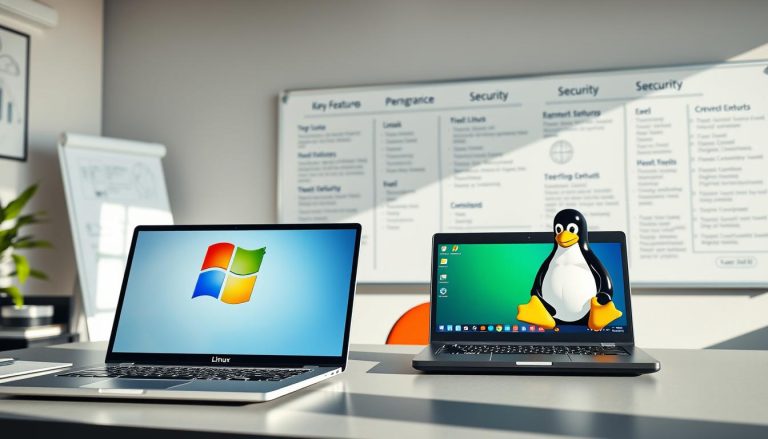Have you ever considered that your computer could run on a completely free, powerful, and secure operating system without restrictive licenses? This possibility became a reality for millions in 2004 with the launch of Ubuntu. Developed by Canonical Ltd., this platform is built on the Linux kernel. It represents a major shift in how people access computing technology. Our goal is to demystify this powerful system for you.
Ubuntu serves as one of the most accessible entry points into the world of Linux. It was specifically designed to make advanced computing available to everyone. You do not need deep technical expertise to benefit from its capabilities.
This platform has evolved far beyond a simple desktop alternative. Today, it powers personal computers, servers, cloud infrastructure, and Internet of Things devices globally. Understanding its dual nature is key: it’s both user-friendly for daily tasks and a robust foundation for professional work.
Key Takeaways
- Ubuntu is a free, open-source operating system based on Linux, launched in 2004.
- It is developed and maintained by the company Canonical Ltd.
- The system is renowned for its ease of use, stability, and security.
- It provides an accessible gateway into Linux for users of all skill levels.
- Ubuntu has grown from a desktop OS to a platform for servers, cloud computing, and IoT devices.
- It offers a powerful combination of a user-friendly interface and enterprise-grade robustness.
Introduction to Ubuntu
The world of operating systems extends far beyond the familiar names, with Linux representing a vast family of powerful, open-source platforms. These different versions, known as distributions or “distros,” offer varied approaches to the same core technology.
Overview of Linux and Ubuntu
Among these many linux distributions, Ubuntu stands out as one of the most popular. It is based on another distro called Debian. Canonical, a British company, introduced this platform in 2004.
Their goal was to create a more user-friendly alternative. Earlier versions of Linux often required significant technical skill to install and use. This distribution solved that problem directly.
Why Ubuntu Matters for Beginners
This operating system matters greatly for new users. It removes traditional technical barriers through an intuitive design and extensive documentation. Beginners can find help easily.
A massive, supportive community is a key advantage. Users around the world contribute answers and tutorials on forums across the internet. This global support network makes learning smooth and less intimidating.
Understanding this relationship helps newcomers. They see this platform as a bridge. It connects the power of Unix-based systems with everyday computing needs effortlessly.
What is Ubuntu? Breaking Down the Basics
Built upon the principle of shared innovation, Ubuntu transforms the traditional software development model. This approach creates a unique computing environment where users gain unprecedented control.
Key Concepts Behind Ubuntu
We define this platform as a complete operating system built on the Linux kernel. It offers a free alternative to proprietary systems like Windows and macOS.
The fundamental concept of open-source software drives Ubuntu’s development. Its code is freely available for anyone to examine and modify. This transparency distinguishes it from closed systems.
Users enjoy complete freedom to adapt the system to their specific needs. They can run diverse applications from web browsers to development tools. This flexibility makes Ubuntu suitable for various computing environments.
The platform belongs to the broader family of Linux distributions. Each distribution offers different approaches while sharing the common Linux foundation. This diversity allows users to choose the perfect fit for their requirements.
Organizations and individuals alike benefit from this open model. They can use and customize the software without licensing restrictions. This empowerment represents the core value of the open-source philosophy.
History and Evolution of Ubuntu
Canonical’s vision for an accessible Linux platform materialized through a carefully planned launch strategy and community engagement. The platform’s journey reflects both corporate direction and grassroots collaboration.
Early Beginnings and Launch in 2004
The initial release addressed a critical gap in the Linux ecosystem. Existing distributions like Debian presented significant installation challenges for average users.
Canonical’s solution focused on simplifying this process while maintaining technical robustness. This approach made advanced computing accessible to mainstream audiences for the first time.
Growth Through Community and Canonical’s Vision
A predictable development cycle became central to the platform’s evolution. Canonical committed to delivering a new version every six months.
This regular update schedule ensured continuous improvement. Long-Term Support releases provided stability for enterprise users, with support extending for multiple years.
The global community played an equally vital role in shaping each version. Canonical provided infrastructure for collaborative testing and support. This partnership between corporate vision and community input defined the platform’s growth.
Over time, the distribution evolved from needing the “Linux” identifier to standing as a recognized brand. This transformation demonstrates successful execution of Canonical’s original Ubuntu vision, detailed further in this comprehensive operating system guide.
Ubuntu’s User-Friendly Interface and Features
The visual experience of an operating system often determines user adoption, and Ubuntu excels in this critical area. Its carefully designed interface removes technical barriers while maintaining powerful functionality.
Intuitive Design with GNOME and Other Environments
Since version 17.10, Ubuntu employs GNOME as its default desktop environment. This clean interface uses icon-based navigation rather than cluttered text descriptions.
The Activities panel sits on the left taskbar, while system controls occupy the top-right corner. Clicking the grid button reveals all installed applications. This streamlined approach makes system navigation straightforward for users at any skill level.
Customization and Pre-installed Applications
Ubuntu Desktop offers extensive customization features. Users can modify themes, layouts, or even switch entire desktop environments. This flexibility accommodates diverse hardware capabilities and personal preferences.
The platform comes pre-loaded with essential software including web browsers, office tools, and media players. Popular applications like Firefox and Spotify are available through the Ubuntu Software Center. Multiple flavors cater to specific needs:
- Kubuntu with KDE Plasma for feature-rich desktops
- Xubuntu using lightweight Xfce for older devices
- Lubuntu with LXQt for maximum performance
- Ubuntu MATE providing a traditional desktop experience
This adaptability ensures the operating system works efficiently across various computing scenarios while maintaining consistent core functionality.
Ubuntu Security and Support
The reliability of an operating system often hinges on two fundamental pillars: robust security measures and comprehensive support frameworks. We examine how this platform addresses both critical aspects through innovative technologies and structured maintenance cycles.
Robust Security Measures and AppArmor Integration
Ubuntu’s open-source nature creates inherent security advantages. Community members constantly review code to identify and address potential vulnerabilities before exploitation. This collaborative approach ensures rapid response to emerging threats.
The platform employs AppArmor, a sophisticated kernel-level security feature. It restricts application behavior and limits system access through predefined profiles. This containment strategy significantly reduces the impact of potential security breaches.
Additional protective features include built-in firewalls and automatic security updates. Full disk encryption protects sensitive data even if devices are lost or stolen. The system encourages best practices like using sudo instead of direct root access.
Long-Term Support and Regular Updates
Canonical’s Long-Term Support (LTS) release model provides exceptional stability. Specific versions receive security updates and comprehensive support for five years. This framework prioritizes consistency over frequent feature changes.
Regular updates maintain system integrity and performance. The dedicated security team monitors emerging threats, releasing timely patches. For enterprise needs, Ubuntu Pro extends this support to ten years with automated compliance tools.
This combination of community vigilance and professional support makes the platform exceptionally secure. Organizations worldwide trust these features for critical operations, knowing their software remains protected through continuous updates.
Ubuntu in Business and Cloud Environments
Modern business operations increasingly rely on scalable, secure computing environments that can adapt to changing market conditions. This platform has emerged as a leading solution for corporate technology needs.
Enterprise Adoption and Compliance Solutions
Enterprise developers consistently rank this operating system as their top Linux choice for mission-critical applications. Its dominance extends to cloud infrastructure, where 67% of organizations now utilize public cloud services.
Real-world implementations demonstrate Ubuntu’s business value. New Mexico State University achieved FIPS compliance requirements using this platform. LaunchDarkly became the first FedRAMP-compliant feature-management platform by leveraging Canonical’s AWS-compatible images.
Business customers benefit from extensive documentation and community resources. Troubleshooting often requires only a simple web search. The long-term support model ensures stability for critical systems over extended periods.
Organizations deploy Ubuntu across diverse functions including web servers, application platforms, and development environments. Containerization technologies enable scalable enterprise solutions that work behind customer firewalls with strict security protocols.
Ubuntu for Developers and Open Source Enthusiasts
Software creation thrives in environments where transparency and shared knowledge accelerate progress. This platform stands as the top choice among enterprise developers for good reason. Its design philosophy aligns perfectly with modern development needs.
We see this preference reflected in professional surveys worldwide. The ranking demonstrates how the environment supports serious software creation.
Community Collaboration and Developer Tools
The open-source nature provides unprecedented access to the system’s code. Developers can examine, modify, and distribute improvements freely. This transparency fuels continuous innovation across the global community.
Collaboration defines the development process. Thousands of users worldwide contribute to testing and problem-solving. More eyes on the code means faster vulnerability identification and resolution.
Canonical’s infrastructure support enables this global cooperation. Hosting servers and forums facilitate knowledge sharing. The ecosystem provides immediate access to essential tools:
- Comprehensive libraries for diverse programming languages
- Development frameworks and containerization technologies
- Debugging utilities and performance monitoring applications
- Integration tools for cloud platforms and version control systems
The decision to use ubuntu offers both enterprise-grade stability and experimental freedom. This combination makes the platform increasingly powerful for projects of all scales.
Ubuntu on Servers, IoT, and Embedded Systems
Enterprise computing environments demand robust platforms that can scale from data centers to edge devices seamlessly. We explore how this operating system extends beyond desktop applications into specialized enterprise and IoT deployments.
Optimized Solutions for Servers and Cloud Platforms
Ubuntu Server provides a specialized platform for managing enterprise infrastructure. It handles heavy workloads efficiently with native support for LAMP stack configurations and container technologies.
The platform dominates cloud computing environments with optimization for major providers like AWS and Azure. This ensures seamless deployment of web servers and application platforms across distributed systems.
Ubuntu Core and Its Role in IoT Devices
For Internet of Things applications, Ubuntu Core offers a secure foundation for embedded systems. It uses containerized Snaps that provide automatic updates and strict isolation between components.
Real-world implementations demonstrate this capability. BeWell’s medical kiosks use Ubuntu Core for remote updates without disrupting patient triage. Grundium’s digital microscopes leverage the platform for distributed collaboration among pathologists.
The system supports diverse hardware from Raspberry Pi to industrial gateways. Ubuntu Pro for Devices extends security updates for up to 10 years, ensuring long-term reliability for business customers.
Benefits of Choosing Ubuntu for Your Needs
The decision to adopt a new platform involves weighing multiple advantages that extend beyond basic functionality. We examine how this operating system delivers exceptional value across financial, performance, and accessibility dimensions.
Cost Efficiency and Versatility Across Devices
Financial considerations often drive technology choices. This platform eliminates licensing fees entirely, unlike proprietary systems requiring significant investments. Users can download, install, and modify the software without restrictions.
Hardware efficiency represents another major benefit. The default Ubuntu desktop interface operates smoothly on systems with less than 1 GB of RAM. Lightweight distributions like Lubuntu function efficiently on devices with just 512 MB.
This resource optimization extends the lifespan of older hardware. It reduces electronic waste while maintaining modern features. The system’s versatility spans personal desktops, enterprise servers, and specialized virtualization environments.
Ease of Use for Both Beginners and Professionals
Accessibility remains a cornerstone of this platform’s design. The intuitive interface welcomes users transitioning from other operating systems. Pre-installed applications cover essential needs immediately after installation.
Professional users appreciate the robust security features and development tools. The clean graphical interface doesn’t require extensive technical knowledge. This dual approach serves diverse user needs effectively.
Multiple distributions allow customization based on specific requirements. From feature-rich environments to minimalist designs, users find the perfect match for their hardware capabilities and workflow preferences.
Conclusion
Our comprehensive examination demonstrates the far-reaching impact of this innovative computing solution. Since 2004, this operating system has transformed how people access powerful technology.
The platform’s versatility spans personal computers, enterprise servers, and specialized devices. This system ubuntu offers remarkable adaptability across different computing environments.
We encourage readers to use ubuntu for their specific needs. The combination of zero cost, robust security, regular updates, and intuitive interface makes it accessible to all skill levels.
Whether exploring alternatives to proprietary systems or seeking enterprise solutions, this platform provides comprehensive support. Understanding its role within the broader Linux distribution family reveals a philosophy of open collaboration that benefits millions worldwide.
FAQ
How does the long-term support (LTS) model benefit users?
What security features make this operating system a safe choice?
Can I run Ubuntu on older hardware or specialized devices?
Why is Ubuntu a popular choice for enterprise and cloud platforms?
How does the open-source development model impact the platform?
What kind of applications and software are available?
Hi, I’m Mark, the author of Clever IT Solutions: Mastering Technology for Success. I am passionate about empowering individuals to navigate the ever-changing world of information technology. With years of experience in the industry, I have honed my skills and knowledge to share with you. At Clever IT Solutions, we are dedicated to teaching you how to tackle any IT challenge, helping you stay ahead in today’s digital world. From troubleshooting common issues to mastering complex technologies, I am here to guide you every step of the way. Join me on this journey as we unlock the secrets to IT success.



